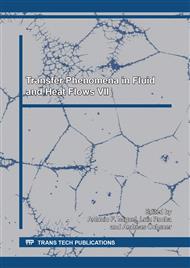p.83
p.91
p.99
p.112
p.125
p.133
p.151
p.161
p.168
Numerical Modeling of Heat Transfer in Taylor-Couette-Poiseuille Systems
Abstract:
The purpose of this work is to model turbulent Taylor-Couette-Poiseuille flows submitted to a temperature gradient. These flows are relevant in many industrial applications including rotating machineries and more especially for the effective cooling of electric motors. Several turbulence closures (k-ω SST, RSM and LES) are first compared in the isothermal case and validated against the reliable experimental data of Escudier and Gouldson [1]. A detailed analysis of the coherent structures within the boundary layers is proposed. The model offering the best compromise between computational cost and accuracy is then used to perform more computations in the configuration with a temperature gradient considered by Kuosa et al. [2]. In their system, the air flow enters the rotor-stator cavity radially. Correlations for the average Nusselt numbers along the rotor and stator as a function of the control parameters (rotation rate, air flow rate, Prandtl number) are provided and compared with data available in the literature [3].
Info:
Periodical:
Pages:
125-132
Citation:
Online since:
January 2019
Price:
Сopyright:
© 2019 Trans Tech Publications Ltd. All Rights Reserved
Share:
Citation:


